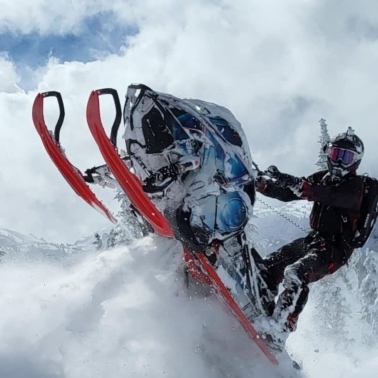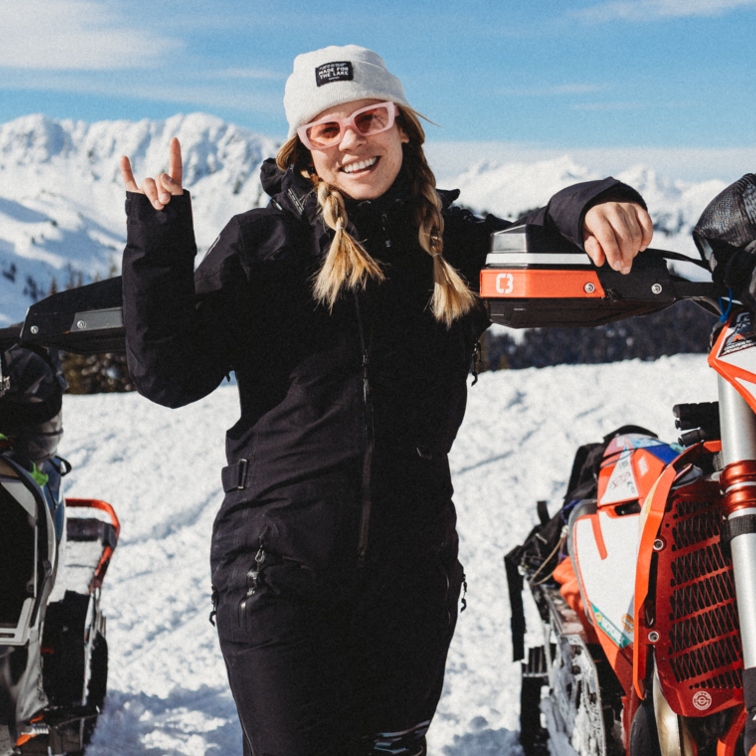Nadine Overwater has spent more than two decades carving her own track through the backcountry. From her childhood on an Alberta farm, ripping around fields on an old Olympic, to running access laps for snowboard missions in the early 2000s, her journey into mountain snowmobiling has always been powered by curiosity, grit and a deep love for winter terrain. When she finally bought her own sled in 2007, it opened a door that would eventually lead to guiding, avalanche forecasting, and becoming one of the most respected leaders in the sport.
In 2012, she founded La Niña Sled Camp to create the kind of supportive, confidence-building environment she wished existed when she started. What began as a small idea has grown into a movement—women learning, laughing, getting stuck, finding their line and discovering their strength together. Today, Nadine still rides hard, still teaches with heart, and remains determined to elevate the next generation of riders while shaping safer, smarter backcountry culture.
How long have you been snowmobiling, and how did you get into the sport?
I grew up on a farm in central Alberta so we always had toys to play with including an old antique Olympic me and my sisters used to get regularly stranded in the field with. Then later on we upgraded to a Polaris 440 Indy Sport, I was about 12 when we got that and it opened up the world for me. I was gone as soon as the bus dropped me off until it was too dark to ride—there was a whole crew of us hooligans that would just sled around the fields until our parents came yelling to get home for dinner.
I started mountain riding in about 2002 (roughly 23 years ago). I was just doubling with my boyfriend at the time and friends, we were strictly using the sleds as access for snowboarding. I finally got my first sled in 2007—it was a SkiDoo 800 Summit Rev with a 144" track and that was a big door opener for me to be on my own sled finally. I was living in Calgary at the time finishing up University and spending every last dime getting to the mountains every weekend to ride.

I understand you founded La Niña Sled Camp in 2012, can you tell us a bit about that?
I did! Yes I had been guiding in Revelstoke for a couple of years for Great Canadian Snowmobile Tours and noticed that there really weren't that many ladies out riding (all my clientele consisted of males) and any women I did manage to get out, found the sport really scary and unapproachable and very few were on machines set up for them (more of the husband's spare sled kind of deal). Nevermind watching their male counterparts trying to teach them how to do it. It was like watching two people who spoke different languages trying to communicate—and quite often there were tears, haha. I had been bugging my boss at the time (the owner of Great Canadian) to let me run some women-specific clinics and he kept brushing me off. I continued to plan it all out behind the scenes and figure out a way to make it happen when he finally gave in. Well, that same winter he had me on the schedule to "help out" with another ladies clinic run by Julie Ann Chapman (now a good friend of mine)—but I was pretty fired up, so I did my duty and helped out with the clinic and a week later I contacted another tenure owner in the area and had my own clinics up and running (since I had already done the leg work). We filled up immediately and my boss got the message and agreed to allow me to run them at Great Canadian—the rest is history. I had been guiding for a while and all the men were really supportive in sending their partners and daughters to me and it just kept growing and growing.
What gap did you see in snowmobile education that made you start a women-only program?
At the time I started up I feel like there were alot of gaps—it was really the grassroots of widespread women getting into the sport. I mean, there were a few, but it was definitely rare to see more than one or two ladies up on the mountain sledding. If I had to chose one though I think it would be just the empowerment/confidence piece. The parking lot is the scariest place, everyone is there—it feels like all eyes are on you waiting for you to take the back window out of your truck while loading or not be able to pull start your cold sled. But you get a group of women together, even if they are struggling, and that takes all that pressure off. I think having some mentorship as well, like an experienced rider or guide (who is also female) helps break down a few of those barriers.
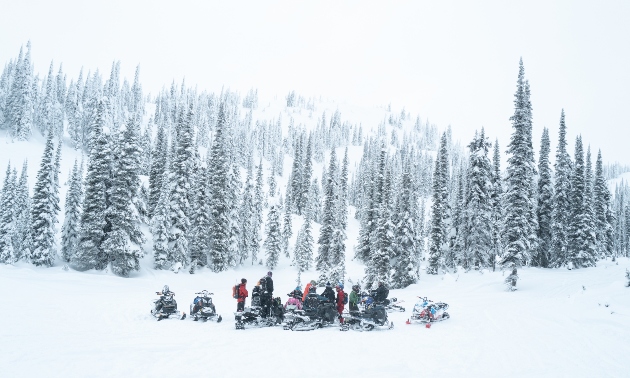
How did your training and career as a professional forester influence your approach to backcountry decision-making and avalanche work?
I think the biggest influence is that I am a total nerd, whether it is trees or snowpack, I want to know everything. Having attended university helped me with the learning portion of the avalanche training—I was able to sit through hours of classroom sessions and retain some knowledge. I was lucky to see the terrain in the summer months and the winter months with my work and had a good handle on really how far away from help we are, as well as what those slopes looked like without snow, how you can get in there, who can get in there, and how often certain areas see natural avalanches. I forged a bit of a path with my forestry employer to allow me to get the training I needed to manage the winter avalanche forecasting program for our logging operations. Luckily I am very persuasive and I think it paid off for both of us.
The nuts and bolts of it are that I loved both of my jobs—forester and avalanche forecasting—and being able to do them at the same time gave me a big niche in the industrial segment. Also the ability to get around on a sled made me really efficient at my job, when other forecasters would have to use ski's I would be covering 10 times the amount of ground getting field observations...
What does an ideal “La Niña” camp day look like, from arrival to après? What are the core skills you aim for participants to leave with?
An ideal La Niña day is the best day ever for any lady. That measurement is usually in the form of an increase in confidence or gaining even a single new skill....or riding friend. The girls are always super nervous when they roll up to camp—so that is where the discussion starts, "Ladies, today we are not going anywhere, so there is nowhere that you are holding us up from getting". Obviously we have a loose plan for locations but it all depends on ability levels and keeping everyone comfortable and stress-free. We review the avalanche forecast and do some basic avalanche training and gear checks and roll out —we actually don't ride in avalanche terrain but we try and drill in this part of the daily process to everyone so that it becomes common practice. Then we go find a big open area, ideally with a bunch of fresh snow and I let the girls go ham for 20 minutes and shake all the stress and cobwebs out, get stuck, squeeze the throttle, laugh, cry, snack and take some photos. After I have seen the level of the group we start to mess around with adjusting cockpits and specific skills. I work them hard in the morning because by lunch only about 50% of them are able to hold onto their sleds anymore. We work on body positioning, weight transfer, throttle control and certain terrain features to really help feel where the sled performs best. Then we head down and help the girls load up and tie down and we head for celebratory drinks and food and early bed to go back and do it again on day 2.
What avalanche training path did you follow (courses/certifications), and what training do you recommend for riders who want to move from recreational to professional levels?
I started with my recreational level course which I did on snowshoes back in 2007!
From there I kind of skipped the middle steps and went straight to the professional stream where I did my Avalanche Operations Level 1 in circa 2010 and moved into Level 2 (Avalanche Professional) in 2016.
For anyone interested in a professional career, the bare minimum in Canada is Avalanche Operations Level 1. You need this course, it is a week long and it is really a door opener for both work and general knowledge— you will either come out overwhelmed or hungry for more.
I am also currently on the board of an organization called Canadian Motorized Backcountry Guides Association (CMBGA), where we are working to standardize the guides training and requirements for snowmobile and snowbike guides much like how the ski world works. This is really exciting and is going to open alot of pathways for people interested into getting into motorized guiding as a career and is well worth checking out if that piques your interest. We are working to make it standardized across North America and Europe in coming years as well.
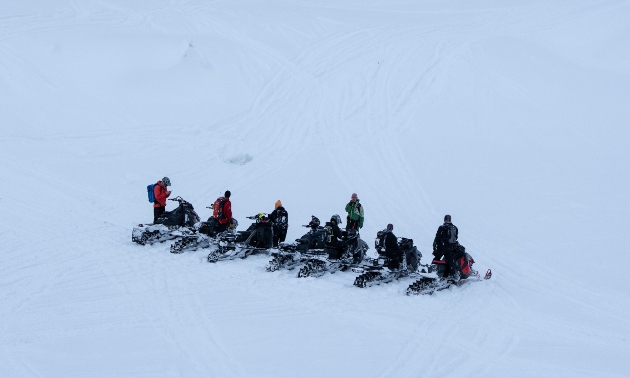
Who are you currently sponsored by, and how have your brand partnerships helped La Niña Sled Camp and women’s participation more broadly?
- SkiDoo
- 509inc
- BCA - Backcountry Access
- CFR - Cheetah Factory Racing
- Munster
The brands love La Nina , it's a pathway to getting more ladies into the sport and ultimately buying their own sleds and gear. My vintage went through the era of absolutely no womens specific riding apparel existing, so it has been really cool watching this develop and being a part of with a few brands to create gear with good function that fits well. The brands help build my reputation and advertise my clinics as well which increases women's participation and I try really hard to deliver a good product so everyone is happy and glad they spent the money.
How do you coach riders through fear or confidence barriers? Are there particular drills or mental strategies you favour?
I make them understand progression—to me you are not going to get really good on your sled until it feels like an extension of your body—and all that takes is seat time. Then once it doesn't feel like you are on a foreign space ship and you aren't scared of every little movement you start with the smallest maneuver. It doesn't matter if you are learning how to powder carve or hit big drops, you work within your ability level, then when that doesn't feel scary anymore, you work your way out into scary territory again, until that doesn't feel scary, then again and again. And control is your biggest asset and the journey is a lot less injury prone if you can maintain control.
Looking ahead, what are the next big goals for you?
Well looking ahead I am going to start my retirement to be honest. It is time for some new blood in this industry for me to pass the torch. I will never quit sledding and I am really enjoying the creative side so I think my main goal is to start getting some skills behind the camera instead of in front of it. That being said, I've still got a few golden years left in me and I want to set the bar really high for the next generation, so have a few things in the works.
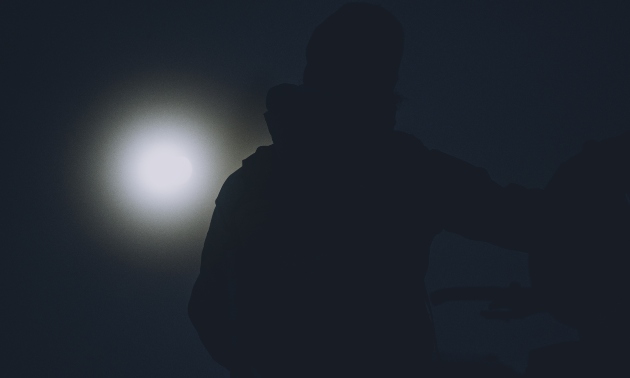
What advice would you offer a new rider just starting out?
I would say to them to ride every chance they get, seat time is everything. Make sure your sled is set up for you (and you are on the right sled for your ability) and just get really comfortable on it. Clinics are also great, or hiring a private guide for a day to get a lesson—if you can't afford that, then seek out local rides or club events you can attend.Skill, Safety and Sisterhood
Make sure you have the avalanche training you need to travel in the backcountry, not only that but first aid and rescue training and you ride with like-minded people whom you trust your life.
Where is your favourite sledding destination?
Hands down, springtime Alaska. I've been to Valdez twice for two weeks and still feel like I haven't even scratched the surface. Also, glaciers are glorious if you've never seen one in real life, you better hurry up.
Is there anything else you would like to share?
Yes. I have been getting asked a lot lately about commenting on the "barriers to women getting into snowmobiling" and I think it is starting to bother me a bit. Maybe I am crazy but I honestly think aside from financial barriers, there is no external barrier. If you want to learn how to snowmobile, you're the only thing stopping yourself—so just go do it already. I have been lucky enough to have support from so many people in my career, men and women alike and the bonds I have built in those mountains with those people make them as close as family.




